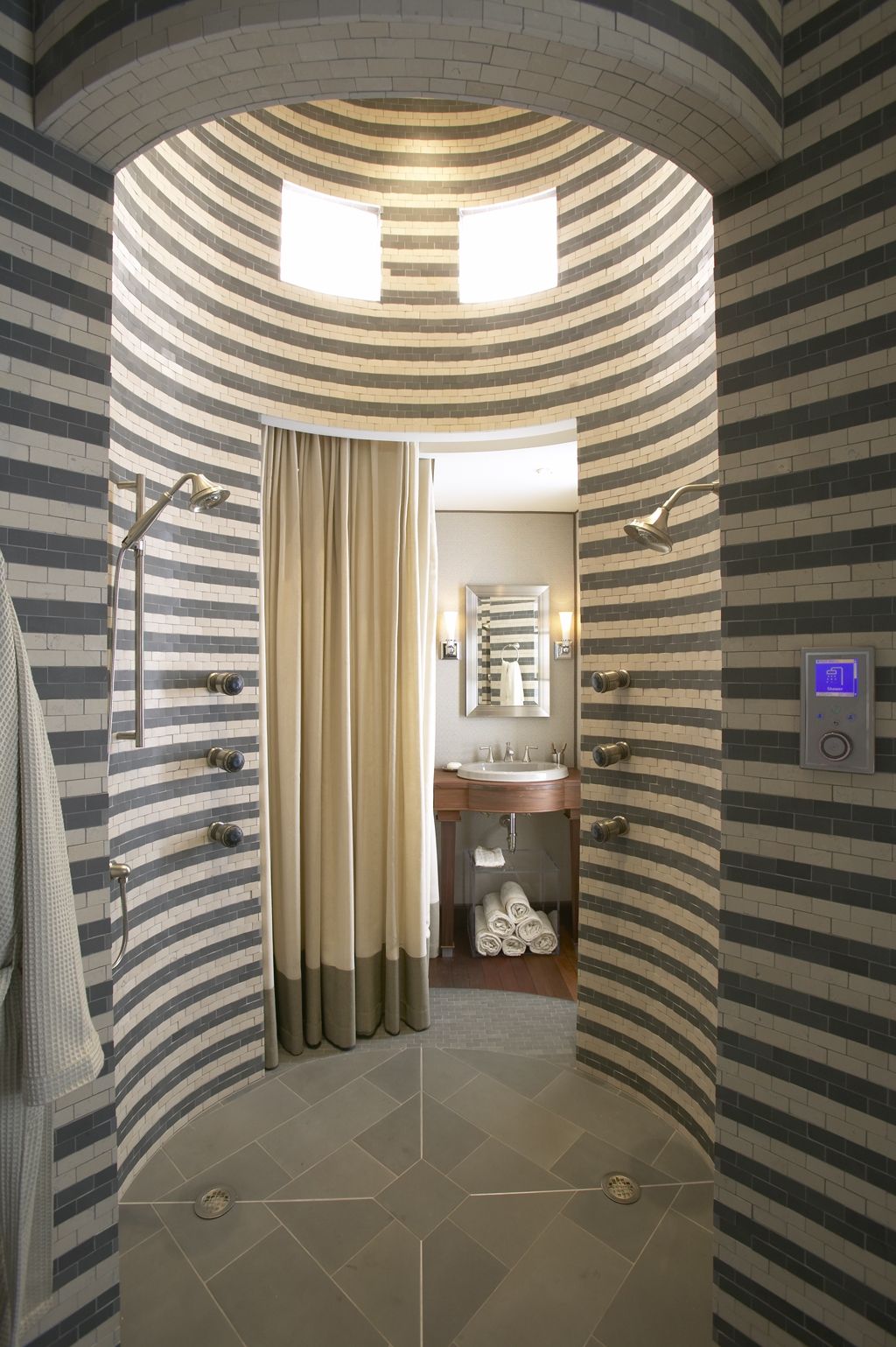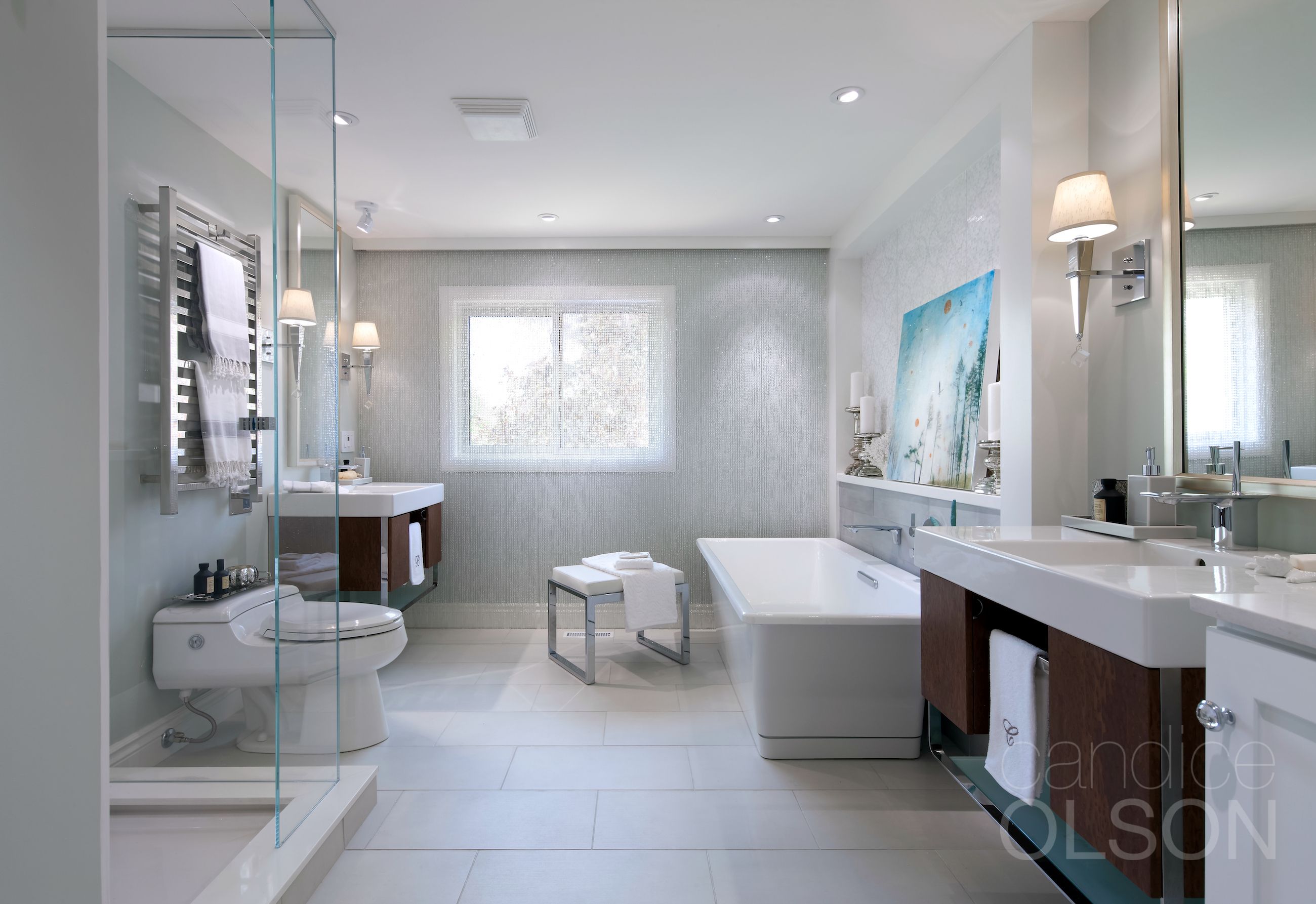The master bath is one of the home’s most intimate and private spaces, where people spend the first and last moments of their days. In the last few decades, however, it has evolved from an exclusively utilitarian space to an intensely personal space built for the affluent homeowner’s comfort, convenience and style. The evidence of this evolution plays out in the spa bath trend, as high-end homeowners seek to create luxe bath spaces that can be both “Zen” and stimulating, depending on the time of day or their mood. In recent years, a push towards “the Internet of Things” has made the spa bath fantasy even more accessible.

Eric Cohler Design Firm, Courtesy of Kohler Co.
“Personally, I think of the master bath as the new age family room — as a place for people to celebrate the almost ritualistic tradition of bathing,” notes New York-based designer Eric Cohler. “I’ve furnished bathrooms with terrycloth upholstered chairs and sofas and fireplaces to provide warmth and ambiance. With ever-evolving technology and a drop in prices extending to bath controls, innovation is now within most homeowners’ reach.”
A Place for Personalization
The new kind of master bath Cohler speaks of — warm, inviting and completely personalized — tends to be more contemporary, more open and more focused on delivering a relaxing experience that only sophisticated design and smart technology can provide. Bath manufacturers have taken note this year, taking advantage of recent advancements in technologies like voice commands and wireless connectivity to unveil innovative products that allow homeowners to have greater control over their homes’ most sacred spaces. Notes designer Candice Olson of HGTV’s “Divine Design” and “Candice Tells All”: “The modern bath, like all technology, has evolved in a manner that offers users countless more features and choices than ever before. The smart bath now goes beyond simply a digital panel controlling basic items like temperature and lighting to offer a complete multi-media sensory experience. Homeowners have endless opportunities for relaxation, rejuvenation and entertainment right at their fingertips!”

Adds Danny Hertzberg of Coldwell Banker Real Estate in Miami: “With smart bath technology, it’s all about convenience. Bathrooms are part of the daily routine and as a result, it is an important area for smart home tech.”
Here are some of the most significant smart bath trends and latest products tantalizing the senses this year.
1. Customized Shower Experiences
According to Hertzberg, who works with some of the most sought-after Miami developers and most sophisticated global clientele, the No.1 most wanted smart bath feature this year is the smart shower — which gives the homeowner a chance to truly customize the bath experience. Olson agrees, saying, “a touch of a button allows you control of water, floor and bench surfaces, multiple-sprays, steam, audio and lighting.”
Thermostatic, programmable shower technologies like the U by Moen allow you to digitally control water quantity, water temperature, water pressure and even the type of spray—from a steady stream to pulsating jets. Each person in the house can customize their preferred shower setting before ever stepping in. With just a few taps on their smartphone, they can start their day with their idea of the perfect “wake-up” shower and finish their day with the “wind-down” settings.

Steam showers with computerized controls are another area of digitalization for the bath. ThermaSol, a steam shower manufacturer, has taken the automated shower a step further with its serenity light, sound and rainhead systems, which allows the homeowner to create a personal spa-like experience and environment with the creative use of light therapy, sound and falling water. The company also offers a touchscreen controller, giving the homeowner the ability to set the steam duration, temperature setting and individual programmed presets such as natural sounds and tranquil visualization scenes.

Concludes Hertzberg: “Who would want to play with exact hot and cold ratio when you can have it programmed as well as your favorite morning jams?”
2. High Tech Toilets
Smart toilets are also very in, says Hertzberg. Cohler agrees, saying that “smart toilets that basically do everything from opening and closing to flushing, warming, cooling, washing and offering color therapy” are among the top requests from his clients. Olson adds that “hands-free operation, comfort and sanitation like toilet seat warmers, integrated hands free bidets and driers, nighttime lighting, self-cleaning/rinsing and air filters,” also remain very popular among her clients. “I’ve just returned from Japan and these are everywhere including the busiest public washrooms.”
The Numi, Kohler’s sleek answer to high-tech commodes, is perhaps one of the most popular smart toilets on the market today. Numi is best known for its motion-activated seat cover, which “even says hello by lifting toilet seat when you approach” says Hertzberg. Other features include a foot warmer to keep toes toasty on early mornings and a complete audiovisual experience, allowing users to pair their smart devices via Bluetooth and play out music from their personal collection or any streaming service. Beyond sound, there’s a visual “wow” factor too: Numi comes equipped with illuminated panels that can be set to cycle through a dynamic range of colors—or scheduled to display certain shades at specific times of day. A multi-user database gives everyone in the household a chance to enjoy their own custom toilet settings—from music and seat warmth to spray pattern and strength.

TOTO Neorest 750H
The Neorest 750H features automated lid operation, automated flushing, automatic deodorizing, multiple bidet wash modes—including oscillating and pulsing comfort washing—and an adjustable heated seat. It also self-cleans. Equipped with Actilight technology, a UV light system built into the lid, the Neorest sets to purifying your porcelain immediately post-usage. The Neorest further burnishes its cleaning credentials with a CeFiONtect ceramic glaze, a misting system that employs electrolyzed water and a tornado flush—all ensuring your toilet will feel fresh for every use. And thanks to the Neorest’s remote control, this can all be done virtually hands-free.
3. Elements of Entertainment
What homeowner hasn’t wished to watch the morning news or listen to his favorite podcast in the bathroom while getting ready for work ? The latest integrated waterproof mirrors allow audiophiles, cinephiles and news buffs to stay connected and remain entertained in their private sanctuary.
“Smart mirrors that switch on and off automatically when facing them” are a top request, says Cohler. As well, televisions concealed behind mirrors — while an older idea — still have currency.”

Séura Hydra Indoor Waterproof TV
Take, for instance, the Séura Hydra Indoor Waterproof TV. This beautiful mirror, with its recessed in-wall design and seamless glass face, magically transforms into a TV when switched on. Available in 19-inch or 27-inch versions, Séura also offers a wide range of finishes for greater customization. Plus, the TVs are easy to clean and fog-free.

Ronbow VENTO Cabinet
If you only want the simple serenity of sound, Ronbow has the answer: the VENTO LED Mirror and Cabinet — a multipurpose, technologically advanced mirror system. Designed by the internationally reputed Italian design house Pininfarina, the 42-inch mirror cabinet includes integrated Bluetooth technology and speakers, a digital clock display and motion activated LED as well as accent mood lighting on left, right and bottom.
4. Warm Ups
Despite advancements in wireless technology and voice command control, there is one element that continues to reign supreme in the luxury smart bath: the gift of warmth. “Towel warmers and radiant heat are features that have become standard,” notes Cohler. Adds Olson: “Towel warming drawers, steam showers with heated seating or reclining surfaces, as well as dry saunas” are among the most popular tech features her clients ask for when it comes to their master baths.
The Riviera towel warmer from WarmlyYours introduces another level of convenience by offering a bundle package with Belkin’s WeMo Wi-Fi Switch, which allows you to use your smartphone or tablet to control the towel warmer from any location. Additionally, the WeMo Wi-Fi Switch integrates with the IFTTT (if this then that) service, which allows users to turn their towel warmers on or off when prompted by another event or activity, such as the sunrise.

VOLA from Hastings Tile & Bath
Pushing the boundaries of design and innovation, VOLA’s electric towel warmer replaces the more common radiator-style warmers with a built-in unit hiding all technical elements behind the wall. Available through Hastings Tile & Bath, the modular system has a self-closing timer which shuts off automatically after two hours at full power and is equipped with temperature regulation from 68° to 120°F.
The Future Smart Bath
Naturally, progress will continue in the smart bath arena. With an eye towards the future, we asked Cohler and Olson to look into their crystal ball and predict what’s next on the horizon for tech-savvy baths. Olson said she “could see a day when tiles or glass shower walls become entire projection surfaces that allow you to visually immerse yourself in any surrounding imaginable. Customization will also evolve so that vanities, toilets and bathtub heights can be raised or lowered to suit users of different heights. Toilets and vanities will feature self-sterilizing steam and UV light sterilization.” The overall idea is that the “pre-set bathroom experience will be initiated with a thumb or iris scan.”
For Cohler, his experience has been that clients have a tendency to overthink technology in their homes. “When this occurs, I find that the homeowner may not understand how to operate the latest controls. To eliminate this stress, we suggest simplification wherever possible. There’s also a persuasive argument that technology changes so rapidly that the simple tried and true is best.”
On the other hand, he adds: “I’m waiting for a smart app that will allow me to turn on the sink, bath or shower at a specified temperature and dispense personalized lotions, soap and shampoo. This can’t be far off…and of course, self cleaning bathrooms would be a huge game changer.”
Regardless of what the future holds for the smart bath, one thing is certain: it will never stop evolving.
Article courtesy of Coldwell Banker Global Luxury
 BCREA’s Position on Flood Protection
BCREA’s Position on Flood Protection












